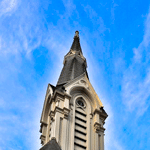 Portland, Oregon, is the 29th most populated city in the United States with more than 2.2 million people living in the metropolitan area. Yet it feels like a small town in many ways; it has a low skyline and a lush Pacific Northwest landscape shadowed by the 11,249-foot-tall Mount Hood, the highest point in Oregon and home to 12 glaciers.
Portland, Oregon, is the 29th most populated city in the United States with more than 2.2 million people living in the metropolitan area. Yet it feels like a small town in many ways; it has a low skyline and a lush Pacific Northwest landscape shadowed by the 11,249-foot-tall Mount Hood, the highest point in Oregon and home to 12 glaciers.
Not surprisingly, the Portland community has rallied around environmental causes, in part because of its natural beauty. The city’s website specifies that it is committed to clean air and water, livable neighborhoods, shared open spaces, transportation, and sustainable economic development, which has led the Mother Nature Network to dub Portland the greenest city in the United States.
Given the city’s focus on sustainability, historic preservation is also very important to Portlandians, who have been committed to preserving The Old Church, a nonprofit event venue located in downtown Portland’s cultural West End. The former church, built in 1882, is a cherished Portland landmark because it is the oldest church that is still standing in the city.
In 2011, The Old Church’s board of directors was faced to confront the reality that the building’s decades-old heating system was unsafe and failing, and it lacked air-conditioning systems, so it hired Imagine Energy, a Portland-based energy consultancy, to update and improve its energy systems. “It was getting uncomfortably hot during the summer, which was a problem given that The Old Church is an event space,” says Jonathan Cohen, founder of Imagine Energy. “It was preventing a lot of people from holding weddings there.”
Imagine Energy evaluated the sustainability of all of the building’s systems while it was working on the air-conditioning. “They were looking for someone to take a holistic look at everything that was going on and come up with a plan of action,” Cohen says, whose 22-person firm works on commercial and residential projects to help their energy use come as close as possible to net-zero. “Buildings have complex systems, complex usage patterns, and complex controls, and we provide energy solutions for these complexities.”
For The Old Church, which is listed on the National Register of Historic Places, preservation was critical. “The board wanted us to find the most sustainable and cost-effective things it could do to improve the building’s energy use and carbon footprint, but it also wanted to preserve the aesthetic of the building,” Cohen says. “We had to make sure anything we were designing didn’t affect the look and feel of the space.”
After the board hired Imagine Energy and raised the funds to do the systems overhaul, Cohen and his team developed an energy model of the building to determine where energy was being lost. “We asked what was the source of the energy, how sustainable that source was, and what we could do to make a difference,” Cohen says. The team discovered that although the existing mechanical equipment was outdated, inefficient, and unsafe, the 1940s-era ductwork was well-built and large enough to handle cooling the building, which was a major sustainability plus.
Cohen’s team also changed the systems used for the main floor from gas forced air to heat pumps. “That lowered our carbon footprint and gave the cooling we were looking for at the lowest energy use and operating cost,” Cohen says.
Imagine Energy initially looked at mini-splits from Mitsubishi, but the firm ended up selecting Bryant equipment provided by Airefco for the majority of The Old Church. Mitsubishi mini splits, provided by Gensco, were used for the building’s office, which had no ductwork. “It was the natural choice,” says Cohen, whose company also hired Knez Building Systems to install insulation in the building’s attic.
It’s been less than a year since Imagine Energy finished the project, which cost just less than $100,000, so hard data isn’t available about energy use, but Cohen’s models point to a 49 percent reduction in energy use and 26 percent reduction in energy costs. Although the measurable data isn’t in yet, the anecdotal results are available. The Old Church was in use for summer 2012, and Cohen says he has evidence that the church is “dramatically more comfortable.”

